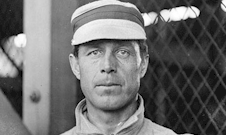In 1969, Major League Baseball celebrated the 100th anniversary of professional baseball. It was hokum, naturally. Pro baseball existed well before 1869, but MLB likes to celebrate things, and that year they chose to honor the history of the game with fanfare. The league organized a group of historians and sports writers, gray hairs all of them, to select the greatest players in history. Joe DiMaggio was chosen as “The Greatest Living Player,” a title he insisted on having included in any introduction for the remainder of his life. Each team provided balloting in their ballparks so fans could select their all-time teams. President Nixon, who actually knew something about the game, chose his all-time team and made a big deal out of revealing it. Several authors published books that helped shape the understanding of the history of the national pastime. After the 1969 season, MacMillan released the first Baseball Encyclopedia, which had a tremendous impact on how people looked at and thought about the game.
Out of these efforts emerged a cloud of opinions, among them thoughts on who the best players were at each position. For many of the positions there was only mild debate. Everyone agreed that Honus Wagner was the greatest shortstop, and everyone assumed Ty Cobb was the best center fielder. Willie Mays was still in uniform, so he would have to wait.
Pie, Home Run, and Jimmy Collins
In the 1960s these new baseball scholars decided that the greatest third baseman of all-time was either Pie Traynor or Home Run Baker. Since one played in the NL and the other in the AL, it was easy to split them up that way. For some reason, Jimmy Collins was shuffled to the side. Prior to 1960, whenever someone would publish their all-time team (say Casey Stengel or Rogers Hornsby), third base discussion would include Collins, who played his final game in 1908. For many years, Collins was the standard-bearer at third, but by the time baseball was releasing balloons and pandering to Tricky Dick for their 100th anniversary, he was a ghost.
There’s a reason why attitudes changed about third basemen. Prior to about 1940, third base was a defense-first position. For many, many years, third base was more important defensively than second base. That’s certainly not the case today, but it makes sense if you think about it. In the deadball era teams bunted a lot, much more than we can probably imagine. Here’s an example: in 1916 there were more than 2,800 sacrifice hits in major league baseball, an average of 176 per team. Scoring was one run per game less in 1916 than it was a century later. There’s no way to know for sure how many bunts were actually attempted each game, because we don’t have data for bunt attempts that were not successful sacrifices. But we can estimate it based on anecdotal evidence and a look at play-by-play data from the World Series in that era.
The story goes that Roger Peckinpaugh, one of the better bunters of the deadball era, had 43 bunt hits in 1919, that was in a short schedule and 122 games. A few sources claim Eddie Collins bunted safely for 40 hits in 1914. We have data dating back to 1950 for bunt hits (with the bases empty) and the highest single-season total is 29, by Brett Butler in 1992. When Butler was active he was famous for laying down a lot of bunts, he was an outlier. In his most active bunting seasons, Butler laid down about 50 bunt attempts. That’s about one every three games, which would certainly be enough to lead you to classify a player as a frequent bunter. Juan Pierre once tried to bunt for a hit 69 times.
If Butler and Pierre are extremes in the modern game, that level of bunting in the deadball era wouldn’t have been uncommon. In the 1914 World Series between Collins’ Philadelphia Athletics and the Boston Braves, the two teams combined for 29 bunts in four games, an average of seven per contest. Fifteen of the bunts were sacrifices and 14 appear to have been attempts to reach base. Of course, the play-by-play does not tell us how many failed bunts were fouled off, but we can assume there were a few. At any rate, seven bunt attempts per game is a lot. A team in 2018 would go three weeks before they matched that number.
All that bunting put stress on the infield, especially at the corners and for the pitcher. A third baseman needed to play shallow, he couldn’t stand back on the dirt and wait for line drives. A player like Jimmy Collins needed to be quick and he needed to anticipate the offense. Collins was, by all contemporary accounts, one of the best at it. He was also credited with having quick feet around the bag and a strong throwing arm.
Third Base was Once a Defense-First Position
Any third baseman who played before 1920 was judged almost solely on how he played in the field. From 1920 to 1940, third basemen were still important defenders, though a few started to put up good numbers at the plate after the rabbit ball was introduced, Traynor among them.
In 1969, folks were still alive who saw Traynor play bunt defense, and of course they remembered that Pie was a .320 hitter. There were not many people around who could still tell you how great Jimmy Collins was. And the sports writers of that era, the ones who cut their teeth on Eddie Mathews and Al Rosen, weren’t taken seriously yet. It took another generation before Mike Schmidt, George Brett and others swallowed up Traynor like Collins had been by his successors.







